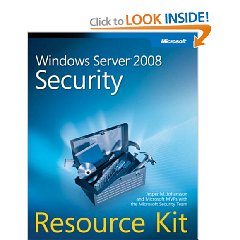 Amazon.com Review
Amazon.com Review
Get the definitive reference for planning and implementing security features in Windows Server 2008 with expert insights from Microsoft Most Valuable Professionals (MVPs) and the Windows Server Security Team at Microsoft. This official Microsoft RESOURCE KIT delivers the in-depth, technical information and tools you need to help protect your Windows® based clients, server roles, networks, and Internet services. Leading security experts explain how to plan and implement comprehensive security with special emphasis on new Windows security tools, security objects, security services, user authentication and access control, network security, application security, Windows Firewall, Active Directory® security, group policy, auditing, and patch management. The kit also provides best practices based on real-world implementations. You also get must-have tools, scripts, templates, and other key job aids, including an eBook of the entire RESOURCE KIT on CD.
Key Book Benefits
Definitive technical information and expert insights straight from the Windows Server Security Team and leading Microsoft MVPs
Provides in-depth information that every Windows administrator needs to know about helping protect Windows-based environments
Includes best practices from real-world implementations
CD includes additional job aids, including tools, scripts, and a fully searchable version of the entire RESOURCE KIT book
Q&A with Jesper M. Johansson, author of Windows Server 2008 Security Resource Kit
The credentials of the contributors to Windows Server 2008 Security Resource Kit are quite impressive. How important was it to assemble such a group for this title?
In my opinion, it was necessary. Server products are necessarily complex, and security, by its very nature, requires a very broad understanding of the product. Developing that understanding in a single person is possible, but very time consuming and still does not lead to the breadth of perspective that you find in a group of people. No single person can truly understand both what it is like to implement Active Directory in a 50,000 seat organization, and how to run a 50-seat small business network long-term, and neither of them is probably going to also be one of the world’s foremost experts on implementing public key cryptography infrastructures. By putting together this world-wide team of experts (representing four countries on three continents) we were able to produce a resource that had far more depth and breadth of knowledge than would otherwise have been possible, and you get the expertise of 12 of the foremost experts on Windows Security in a single package.
What extras are available on the Resource Kit CD?
First, you get a bonus chapter on Rights Management Services, as well as an electronic copy of the entire book. I am very excited about the electronic copy because it provides a searchable way to read the book. These types of books are always used as references and being able to search it is very valuable.
You also get some tools that may come in handy for managing servers. Scripting Guru Ed Wilson wrote some custom PowerShell scripts specifically for this book to manage user accounts and other security related aspects of your deployment. In addition, I wrote a couple of tools for the book. One is my password generator, which I first made available several years ago. It enables you to manage unique administrator account passwords and service account passwords on hundreds or thousands of servers on a network. I also included my elevation tools, which allow you to launch an elevated instance of Windows Explorer, as well as elevating any command you want from the command line. Having worked with User Account Control (UAC) daily for about two years I find that one of the biggest impediments to running under UAC is the multiple prompts you get when you perform many file operations. As an administrator, that is a very common task. Elevating Windows Explorer lets you do those operations with a single elevation prompt, and still leave UAC turned on.
Comparing the two programs, what are some of the fundamental differences between Windows Server 2008 and Windows Server 2003?
To me, the biggest difference is the fact that while Windows Server 2003 was built under the security best practices of 2002, Windows Server 2008 incorporates all the secure development practices Microsoft learned in the five years since. The field of secure software development has progressed immensely between 2002 and 2007, and incorporating them will make Windows Server 2008 much more able to stand up to the threats we will see in the next five years. By the way, it is with a heavy heart that I say that, as I worked hard on security in Windows Server 2003, but it is true.
Apart from the engineering process, the first thing people will notice is the completely new management model in Windows Server 2008. Instead of installing a lot of separate components, you now deploy roles to the server. This makes a lot of sense because the roles are what you bought the server to fill. By implementing that metaphor in the management tools the risk for misconfiguration is greatly reduced.
The new kernel features are also very important and will make a big difference for many. First, the new virtualization features are fundamentally going to change how we build and run data centers. The improvements in security, reliability, and performance in the kernel features, such as thread scheduling, and in the networking features, such as the new network file system, also are going to be valuable to many.
What do you feel is the biggest security oversight made by network admins?
Put a slightly different way, the area where I see the most room for improvement is in security posture management. Administrators are far too focused on vulnerabilities and on the types of “hardening” tweaks that were useful in the 1990s, when software shipped wide open by default. Today, those things are not nearly as important as it is to manage the security posture of your servers. Far too many administrators still believe in the perimeter and fail to recognize that just about every organizational network today is semi-hostile, at best. The biggest security oversight is not to analyze and manage the threats posed to servers by other actors on the network. The Security Resource Kit goes into depth in discussing what I refer to as Network Threat Modeling, as the analysis phase of Server and Domain Isolation – probably the most powerful security tool in the arsenal today. Yet, the proportion of networks that use these tools is infinitesimal.
What are your thoughts on the constant hype surrounding potential security flaws in Vista?
As I have written elsewhere (http://msinfluentials.com/blogs/jesper/archive/2008/01/24/do-vista-users-need-fewer-patches-than-xp-users.aspx) I fail to see any data backing up the argument. Certainly, there have been flaws in Vista – and anyone who expected it to be flawless was unrealistic – but the improvements are tremendous over Windows XP. Windows Vista has about half as many critical problems as Windows XP in the same time-frame. I’m not sure that it would have been reasonable to expect it to perform much better than that given how large and complex modern software is and how fast the security landscape is moving.
Therefore, I have to think that the reasons for the hype are something other than data. The popular press seems to operate on the assumption that complaining about Microsoft generates advertising revenue, and they are probably correct. The fact of the matter today is that a significant portion of the software industry, specifically the security portion, has built its business almost exclusively on selling software that purports to protect Microsoft’s customers from Microsoft’s screw-ups. It is simply terrifying to it, and a grave threat to its business model, that Microsoft should actually manage to produce software, and particularly operating systems, that are so secure they do not need most of the products that portion of the industry sells.
The popular press, being a largely advertising funded business, has happily latched on to this perception and boosted the unsubstantiated claims of Windows Vista’s vulnerability to the benefit of their major advertisers. It is truly a sick eco-system that harms the customer in both the short and long term. The threats today, as I mentioned above, are trending toward the types of things that the security software industry cannot protect against. The new threats are against people, and the focus needs to shift to helping people make better security decisions and take responsibility for their own actions. Unfortunately, the current unsubstantiated hype about Windows Vista is not about protecting customers, it is about selling unnecessary security software and inculcating users and IT managers alike in the belief that they must buy third party software to run Windows safely; a belief that, with a few notable exceptions, such as anti-virus software, is falsified by the data. In fact, the hype has even lead to a huge growth industry in malicious, fake, security software. I have seen a lot of people lured by the hype into buying security software that is not security software at all, but simply malware in disguise. The average consumer, inundated with hype, is unable to make out what to really believe. This sick ecosystem is harmful and the press and the pundits are not helping, but only increasing the hype.
In your opinion, which network faces the biggest security risk today: the small office with multiple power users or large corporation with a large LUA base?
The unmanaged networks. I have seen very well managed and very secure networks in both small and large organizations, and I have seen poorly managed and very insecure networks in both as well. It is not really a matter of size but of how much time and effort is put into the security aspects of it. One of the largest weaknesses seems to be training. Security today is about end-points. The attacks are against people far more prevalent than those against technology and vulnerabilities. We need to, as an industry, understand how to push the security out to the assets that we are trying to protect. In the past we have centralized security because it was a way to centralize management of security. The challenge now is to de-centralize security, while still permitting centralized management. This is a non-trivial task, but it must be done. As a starting point, I dare every IT manager to start analyzing the risks to his or her network, and specifically, what it is they want the network to be used for. Once you understand what it is you want the network to provide you have a chance to work on making it provide that and nothing else. To me, that is the most important thing we can do. A properly staffed IT group, with adequate training and resources to train its users, an organizational mandate to protect the organization’s assets, and a keen understanding of the business they serve will build a network that is adequately secured regardless of the size of the network. Windows Server 2008 certainly provides some very powerful technologies to help you manage security in your network, but while that is a necessary component, it is insufficient by itself. At a very base level, it is about the people and the processes you have, more than about the technology. Technology will help, but it is just a tool that your people will implement using a process that helps or hurts.
About the Author
Jesper Johansson, Ph. D. in Management Information Systems, has 20 years experience in information technology security. He is a security architect for a large e-commerce company, responsible for application security strategy across the range of properties and services. Prior, he was a security manager for Microsoft Corporation. He is author of several TechNet Magazine security articles and is a co-author of two other security books, Protect Your Windows Network and Windows Vista Security. When he is not working on information security, he teaches scuba diving.
The Windows Server Security Team designs, develops, tests, and supports Windows Server security solutions for Microsoft.
Book Details
- Paperback: 750 pages
- Publisher: Microsoft Press (March 10, 2008)
- Language: English
- ISBN-10: 0735625042
- ISBN-13: 978-0735625044
- File Size: 7.3 MiB
- Hits: 712 times
 Book Description
Book Description Book Description
Book Description Book Description
Book Description Book Description
Book Description Book Description
Book Description Book Description
Book Description

 Book Description
Book Description Book Description
Book Description Book Description
Book Description Book Description
Book Description
 Book Description
Book Description Amazon.com Review
Amazon.com Review Book Description
Book Description Book Description
Book Description Book Description
Book Description


 Book Description
Book Description